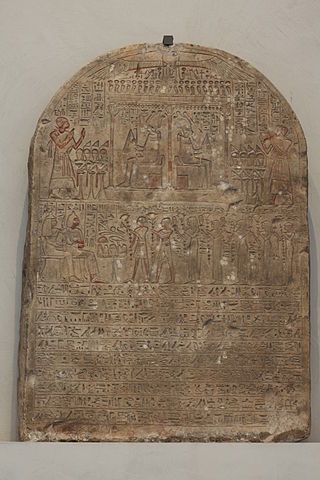Related Research Articles

Memphis, or Men-nefer, was the ancient capital of Inebu-hedj, the first nome of Lower Egypt that was known as mḥw ("North"). Its ruins are located in the vicinity of the present-day village of Mit Rahina, in markaz (county) Badrashin, Giza, Egypt. This modern name is probably derived from the late Ancient Egyptian name for Memphis mjt-rhnt meaning "Road of the Ram-Headed Sphinxes".

Ptah is an ancient Egyptian deity, a creator god and patron deity of craftsmen and architects. In the triad of Memphis, he is the husband of Sekhmet and the father of Nefertem. He was also regarded as the father of the sage Imhotep.

Seker is a hawk or falcon god of the Memphite necropolis in the Ancient Egyptian religion, who was known as a patron of the living, as well as a god of the dead. He is also in some accounts a solar deity as for The Temple of Seker in Memphis.
Prince Khaemweset was the fourth son of Ramesses II and the second son by his queen Isetnofret. His contributions to Egyptian society were remembered for centuries after his death. Khaemweset has been described as "the first Egyptologist" due to his efforts in identifying and restoring historic buildings, tombs and temples.

Isetnofret was one of the Great Royal Wives of Pharaoh Ramesses II and was the mother of his successor, Merneptah. She was one of the most prominent of the royal wives, along with Nefertari, and was the chief queen after Nefertari's death.
Ptahmose or Ptahmes may refer to:

Ptahmose was a High Priest of Amun and Vizier of southern Egypt-(Upper Egypt), under Amenhotep III. Certain historians place him at the end of the reign in 1378 BC. Others place him in the first part of the reign.
Ptah-Du-Auu was a nobleman and priest in ancient Egypt, who lived during the 4th dynasty. Ptah-Du-Auu was named after the god Ptah, whom he served.

The High Priest of Ptah was sometimes referred to as "the Greatest of the Directors of Craftsmanship". This title refers to Ptah as the patron god of the craftsmen.

Pahemnetjer(p3-ḥm-nṯr; "servant of the god", "priest") was a High Priest of Ptah during the reign of Ramesses II. Pahemnetjer succeeded Huy as High Priest of Ptah and was in turn succeeded by his son Didia.
Didia was High Priest of Ptah during the reign of Ramesses II. Didia succeeded his father Pahemnetjer into the office of High Priest of Ptah.
Maya or May was a High Priest of Amun of ancient Egypt, until at least year 4 of Akhenaten.

Ptahmose was High Priest of Ptah in Memphis during the time of Thutmose III of the 18th Dynasty.
Ptahmose was High Priest of Ptah in Memphis during the time of Thutmose IV and in the beginning of the reign of Amenhotep III.

Ptahmose was High Priest of Ptah in Memphis during the time of Thutmose IV and/or Amenhotep III. He was the son of a Prophet (priest) named Menkheper. Ptahmose's son Pahonte would later serve as High Priest of Ptah.

Sehetepebreankh-nedjem was an ancient Egyptian official with the titles royal sealer, foremost of action, Sem-priest and Great one of the leaders of craftsmen. The latter title is that of the High Priest of Ptah. The god Ptah was the deity of arts and crafts and therefore, the high priest of Ptah had a title related to crafts. Sehetepebreankh-nedjem is known from a group statue showing him, his son and his grandson. The statue was dedicated by his son Nebpu, who was also High Priest of Ptah. The statue is datable by style to the end of the Twelfth Dynasty and is now in the Louvre. The statue was bought in 1816 by the Louvre and is most likely from Memphis. This city was the major cult centre for Ptah.

The ancient Egyptian noble Prehotep II was Vizier in the latter part of the reign of Ramesses II, during the 19th Dynasty.
This page list topics related to ancient Egypt.
Thutmose was an ancient Egyptian vizier under Amenhotep III, during the 18th Dynasty.

The Genealogy of Ankhefensekhmet or Genealogy of the Memphite priestly elite is an ancient Egyptian relief – sometimes referred to as a stela – normally identified as having been made during the 8th century BCE, under the reign of pharaoh Shoshenq V of the late 22nd Dynasty. A surviving block is kept at the Egyptian Museum of Berlin. The relief was issued by a priest called Ankhefensekhmet with the purpose of illustrating his own genealogy. The relief traces back Ankhefensekhmet's sequence of ancestors up to 64 generations before, with the earliest individual, Ptahemheb, identified by Ritner as being from the time of Nebhepetre of the 11th Dynasty and alternatively identified by Borchart as being from the time of Nebkaure Khety of the 10th Dynasty. On 25 occasions the genealogy also names the pharaoh or king who was ruling at the time.
References
- ↑ D.B. Redford, "The Coregency of Tuthmosis III and Amenophis II", The Journal of Egyptian Archaeology, Vol. 51 (Dec., 1965)